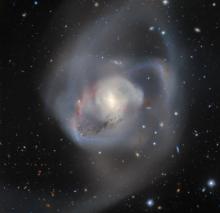Listen to today's episode of StarDate on the web the same day it airs in high-quality streaming audio without any extra ads or announcements. Choose a $8 one-month pass, or listen every day for a year for just $30.
You are here
Hyperactive Galaxy
Our home galaxy, the Milky Way, is a giant spiral that contains hundreds of billions of stars. And every now and then, one of its stars explodes as a supernova. The last time astronomers saw that happen was more than 400 years ago, but that may be because we can see only a small portion of our vast galactic home. If we were outside the Milky Way, astronomers estimate, we’d see about two supernova explosions per century.
We’ve seen supernova explosions in many galaxies beyond our own. But one prolific galaxy puts all the others to shame. It’s a beautiful spiral in the constellation Cepheus known as NGC 6946. During the past hundred years, astronomers have seen a record 10 supernovae in this one galaxy.
The galaxy owes those fireworks to its impressive star-spawning ways. Its gas and dust are giving birth to large numbers of new stars. The most massive of these stars explode a few million years after their birth, producing the fireworks we see.
As galaxies go, NGC 6946 is fairly close — about 20 million light-years from Earth. That means these stars actually died 20 million years ago, but it’s taken that long for the light of their explosions to reach us. Astronomers first saw a supernova in this galaxy a hundred years ago, back in 1917. The most recent popped off just a few months ago.
The supernova count might have gone even higher, but instead of exploding, one massive star collapsed to form a black hole. More about that tomorrow.
Script by Ken Croswell, Copyright 2017





